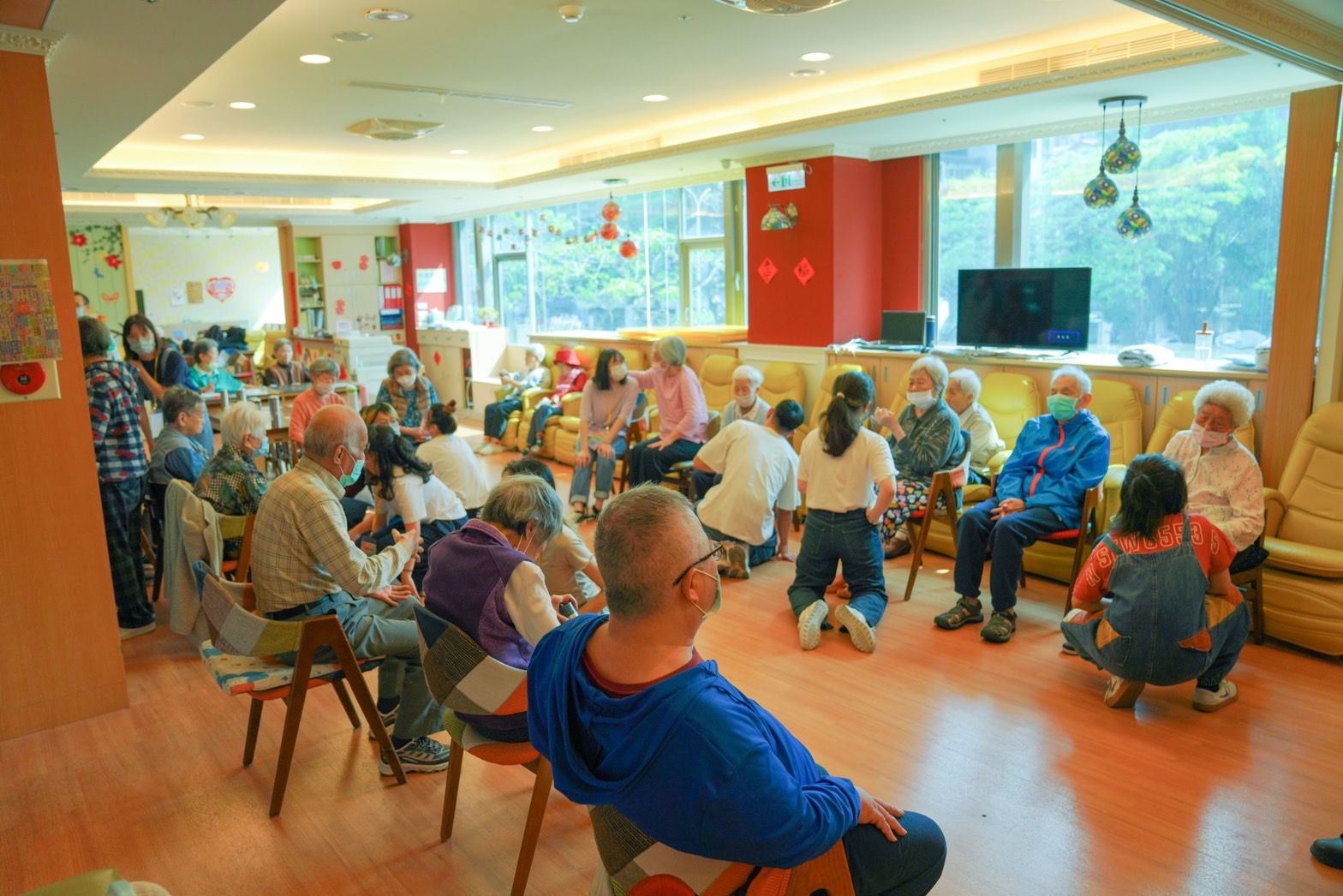Reporters/LU,SUM-YIN, HUANG,LI-LIEN, HU,YU-HSIN ,SHAVELA VALENSKA
With advancements in medical technology and a decrease in the global fertility rate, the aging population has become a common challenge worldwide. According to the World Health Organization (WHO), a population aged 65 years old or older accounting for 7%, 14% and 20% of the total population is called an “aging society,” an “aged society,” and a “super-aged society,” respectively. In 1993, Taiwan entered the aging society, and in 2018, Taiwan became an aged society. Taiwan is estimated to become a super-aged society by 2025, making it the fastest aging population in the world.
Chen, Xiu-zhen (陳秀珍), professor of the Department of Long-Term Care in Kang Ning University, said that an aging population is accompanied by many social problems, including labor shortage caused by declining youth populations, increased spending on social welfare and security, and increased demand for health workers and facilities. The National Development Council also predicted that in 2065, the proportion of elderly people in Taiwan will exceed 40% of the population, resulting in an increased pressure for the working population to support the elderly. By that time, every 1.2 young citizens in Taiwan will need to support one elderly.

Small Efforts Make Big Progress
Wu, Nai-ru (吳迺茹) is a 58-year-old working woman in New Taipei City who takes care of her nearly 90-year-old sick father-in-law and mother-in-law. Wu’s father-in-law suffers from Alzheimer’s disease, and constant supervision is needed. Although his physical functions are still normal, he can not express himself clearly and has symptoms of delusions, causing him to occasionally wander off. While Wu’s mother-in-law has Parkinson’s disease, coupled with symptoms of slowed movement, dementia, and frequent urinary tract infections, as well as a decline in her mental health. Hence, Wu needs to accompany her to have regular doctor checkups.
“When family members are sick, in addition to taking care of them, it is extremely important to provide companionship and encouragement,” Wu stressed. Juggling work and taking care of her parents-in-law could be challenging. In the end, in order to ensure that her mother-in-law has good care when she was not around, Wu has to send her to a nursing home and hire a 24-hour caregiver. Although the cost of the nursing home and the caregiver was nearly NT$130,000 ($4,249) a month, Wu still considered it’s worth it. When it comes to the cost of these elderly care services, she stated that fortunately they have good financial support. However, she expressed concerns for families that are not financially stable, hoping that the government can lower the fees of nursing homes and other facilities so as to make basic care and support more accessible for the elderly.

Taiwan’s LTC Policy
To respond to Taiwan’s aging population, the government implemented a national ten year Long-Term Care (LTC) 2.0 plan in 2015. LTC 2.0 is the new and revised version of LTC 1.0 which was enacted in 2007. In fact, LTC 2.0 has expanded its service to citizens of different ages with various disabilities including 50 years old and older citizens with dementia, citizens with proof of mental or physical disability, 55 years old and older aboriginal citizens, and 65 years old and older citizens. Moreover, LTC 2.0 added 9 new services, offering a total of 19 services which citizens can inquire about by calling the 1966 LTC service hotline. These 19 services are distributed to 4 categories: care and professional services, transportation services, assistive devices and home accessibility improvement services, and respite care services.
Furthermore, LTC 2.0 emphasized the importance of establishing a comprehensive integrated long-term care environment in the community with ABC Community Overall Care Models offering three-tier services. Tier A Community-Based Integrated Service Centers provide formulated long term care service plans for the disabled. While Tier B Combined Service Centers provide assisted long term care services such as home rehabilitation, catering, day care, transportation, and respite care services. Moreover, Tier C Long-Term Care Stations in Alleys and Lanes provide social participation, health promotions, as well as disability prevention and delay services.
Professor Chen, Xiu-zhen pointed out that due to the common filial piety belief in Taiwan, some citizens are reluctant to use these services. Chen still praised the government’s efforts in tackling the aging population problems. Moreover, she found the respite care service to be particularly important as “caregiver needs care too.” Huang, Ya-han (黃雅涵), a nurse from an NGO day care center, found Tier B and Tier C to be the most vital services as they aim to prevent elderly people from needing a residential institute.

Although Taiwan has put a lot of effort into its Long-Term Care plan, social worker Zeng, Hao-yu (曾浩瑜) believed that the government should also pay attention to the well being of health care workers. Zeng argued that in order to prevent misuse of provided services, service job descriptions should be clearer. Zeng recalled stories of how families of the elderly have treated social workers as house cleaners, asking them to do tasks that the families were able to do themselves. Nurse Huang, Ya-han further supported this claim by saying that ensuring a good working environment for health care workers is the key to a sustainable long-term care plan. Furthermore, Zeng claimed that the government is providing too many subsidies to its citizens. For example, Taiwan citizens only need to pay about NT$30 ($0.98) to enjoy bathing senior citizen service, with the remaining NT$220 ($7.19) being subsidized by the government. Zeng argued that government subsidies should be rationalized to prevent insufficient resources for future generations. Moreover, they should be given to those who really need them.
To ensure a better future for LTC, Professor Chen, Xiu-zhen believed that in order to strengthen the health of future senior citizens, the government should focus more on maintaining citizen’s physical and mental health while they are healthy. “Humans are like machines; with proper maintenance, we may use our body for a long time. Otherwise, problems may occur in the future,” said Chen. Interpersonal relationship is also an important factor to ensure senior citizen’s well-being. She proposed that the government should explore alternative solutions, such as setting up senior citizens’ coffee shops and cohabitation of elderly and young people to help maintain elderly people’s health.
NGOs Contributions in Tackling Aging Population’s Problems
In addition to the four major care systems established by the government, non-governmental organizations (NGOs) have also made significant contributions to Taiwan’s long-term care policy. Several NGOs are implementing the LTC policy based on Taiwan’s ABC Community Overall Care Models. NGO day care center nurse Huang, Ya-han worked in the Combined Service Center (Tier B). She stated that the elderly will be recommended to the day care center based on the assessment done by the government through the 1966 hotline. The NGO day care center provides placement service, day care, and respite service. Huang further stated that the government provides subsidies for their service, so the elderly only need to pay an average of NT$100-200 ($3-$7) each time they use the service.
Zeng, Hao-yu is a social worker of the Community-Based Integrated Service Centers (Tier A). He explained that a lot of elderly who live alone lack the ability to undertake everyday tasks. As a home-based social worker, Zeng helped the elderly to maintain good hygiene, eat a variety of nutrient-dense food, and help them to connect to the outside world. However, he pointed out that these services are quite limited, as social workers are unable to keep the elderly company for 24 hours a day. Zeng recalled how he was faced with different problems in each of his visits, including finding expired food, cockroaches and mice crawling around, and molding around the house where the elderly reside. Some elderly even smelled unpleasant due to their inability to take a shower. Despite all these underlying problems, Zeng tried to focus on the things he could do, such as bringing extra healthy meals to the elderly for them to reheat themselves on the days he was unable to come.
Long-Term Care Stations in Alleys and Lanes (Tier C) services are found in many neighborhoods in Taiwan. Each neighborhood has a senior center that offers classes and activities for senior citizens to socialize. These services welcome all senior citizens, and assessments are not needed for one to participate. Tier C services aim at preventing and delaying the aging process, and these senior centers can also be used as temporary care sites where seniors can be cared for.

Different Countries’ Long-term Care Policies
According to Professor Chen, Xiu-zhen, who has visited long-term care institutions in many countries, every country in the world has different approaches in dealing with population aging issues, with Taiwan’s current LTC policy being similar to that of Japan. The four major services in Taiwan’s LTC 2.0 are in fact slight adjustments from Japan’s LTC model. However, Chen pointed out that the major difference between Japan’s LTC system and that of Taiwan is that the LTC system in Japan operates similarly to an insurance system. It emphasizes user fee, thus Japan does not have the negative social phenomenon seen in Taiwan, where people overuse the LTC system, Chen lamented.
During her visit to Australia, Professor Chen, Xiu-zhen observed that the elderly in long-term care institutions seemed relaxed, chatting, and enjoying afternoon tea in a cafe-like setting. This is something that she had not seen in Japan or Taiwan. Chen hoped that Taiwan can provide a similar environment to the elderly in the future. “In Australia, the overall health of elderly and their freedom of choice are highly valued,” Zeng said. He believed that in this way, the elderly could have dignity even at the end of their life. However, he acknowledged that the high cost of facilities in Australia is the reason why they can provide the elderly with such an ideal environment.

Population aging is a phenomenon that affects all people. In Taiwan, long-term care policy has evolved from 1.0 to 2.0. The government has exerted tremendous efforts to provide assistance, expand services, target more age groups, and address the needs of caretakers. Despite the various challenges, such as cost, misuse of service, and lack of health care workers faced by Taiwan’s long-term care system, Taiwan government and NGOs have continued to work together to find solutions to move forward on the path of long-term care. “Taiwanese are very fortunate,” Zeng, Hao-yu said. He believed that the government is committed to taking care of its citizens from the moment they enter into this world to the moment they leave the world. The government understands the importance of caring for senior citizens who have contributed so much to the society. Hence, a better revised long-term care 3.0 can be expected in the future. In sum, Taiwan stands a good chance of effectively addressing the issue to enable its senior citizens to grow old with dignity and comfort.


